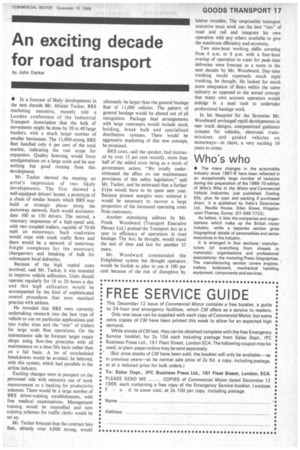An exciting decade for road transport
Page 19

If you've noticed an error in this article please click here to report it so we can fix it.
by John Darker • In a forecast of likely developments in the next decade Mr. Alistair Tucker, BRS marketing executive, recently told a London conference of the Industrial Transport Association that the bulk of movements might be done by 20 to 40 large hauliers, with a much larger number of smaller businesses. The 11,000-strong BRS fleet handled only 6 per cent of the total market, indicating the vast scope for expansion. Quality licensing would force amalgamations on a large scale and he saw nothing but good coming from this development.
Mr. Tucker showed the meeting an artist's impression of two likely developments. The first showed a well-equipped drivers' hostel, a prototype of a chain of similar hostels which BRS may build at strategic places along the motorway network. Each would accommodate 100 to 150 drivers. The second, a visionary impression of a high-speed unit, with two coupled trailers, capable of 70-80 mph on motorways. Such road-trains would cope with trunk traffic flows and there would be a network of motorway freight complexes for the necessary changeovers and breaking of bulk for subsequent local deliveries.
Because of the high capital costs involved, said Mr. Tucker, it was essential to improve vehicle utilization. Units should operate regularly for 18 to 20 hours a day and this high utilization would be accompanied by the kind of sophisticated control procedures that were standard practice with airlines.
He revealed that BRS were currently undertaking research into the best type of vehicle to use on particular applications and into trailer sizes and the "mix" of trailers for large scale fleet operations. On the maintenance side he forecast larger repair shops using flow-line principles with all maintenance on a time /life basis rather than on a fail basis. A lot of unscheduled breakdowns would be avoided, he believed, with this system, which had parallels in the airline industry.
Exciting changes were in prospect on the personnel side with extensive use of work measurement as a backing for productivity schemes. There would be a large number of BRS driver-training establishments, with free medical examinations. Management training would be intensified and new training schemes for traffic clerks would be set up.
Mr. Tucker forecast that the contract hire fleet, already over 4,000 strong, would ultimately be larger than the general haulage fleet of 11,000 vehicles. The pattern of general haulage would be altered out of all recognition. Package deal arrangements with large customers would include stock holding, break bulk and specialised distribution systems. There would be aggressive marketing of this new concept, he promised.
BRS costs, said the speaker, had increased by over 12 per cent recently, more than half of the added costs being as a result of government action. "We totally underestimated the effect on our maintenance provisions of this safety legislation," said Mr. Tucker, and he estimated that a further Elfin would have to be spent next year. Because present margins were minimal it would be necessary to recover a large proportion of the increased operating costs from customers.
Another stimulating address by Mr. Frank Woodward (Transport Executive Plessey Ltd.) praised the Transport Act as a spur to efficiency of operations in road haulage. The Act, he thought, would stand the test of time and last for another 35 years.
Mr. Woodward commended the Freightliner system but thought operators would be foolish to plan to use it 100 per cent because of the risk of disruption by labour troubles. The responsible transport executive must work out the best "mix" of road and rail and integrate his own operation with any others available to give the maximum efficiency and economy.
Two nine-hour working shifts covering from 6 a.m. to 8 p.m. with a four-hour overlap of operation to cater for peak-time deliveries were forecast as a norm in the next decade by Mr. Woodward. Day-time trunking would supersede much night trunking, he thought. He looked for much more integration of fleets within the same industry as opposed to the unreal concept that many own account operators would indulge in a mad rush to undertake professional haulage work.
In his blueprint for the Seventies Mr. Woodward envisaged rapid developments in new truck designs, computerized guidance systems for vehicles, electronic transmissions and guided vehicles on motorways—in short, a very exciting 10 years to come.
Who's who
• The many changes in the automobile industry since 1967-8 have been reflected in an exceptionally large number of revisions during the preparation of the 1969-70 edition of Who's Who in the Motor and Commercial Vehicle Industries, just published. Costing 50s, plus 4s post and packing if purchased direct, it is published by Kelly's Directories Ltd., Neville House, Eden Street, Kingston upon Thames, Surrey (01-546 7722).
As before, it lists the companies and organizations which make up the British motor industry, while a separate section gives biographical details of personalities and senior executives in the industry.
It is arranged in four sections: manufacturers (of everything from chassis to materials): organizations and professional associations: the motoring Press; biographies. The manufacturing section covers engines, trailers, bodywork, mechanical handling equipment, components and services.
























































































































































